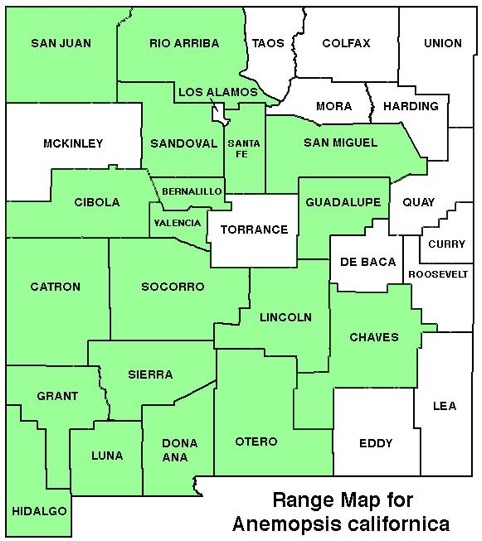WILDFLOWERS OF NEW MEXICO

Wetland plant spreading by rhizomes, often forming a solid groundcover with a dense mat of leathery basal leaves. Note the 6–20-inch tall, leafy flower stems have 5-8 large, white, petal-like bracts below a spike crowded with smaller white bracts, so the combination resembles a single flower.
FLOWER: March–September. 5–8 showy, petal-like bracts sit below a conical spike packed with up to 100 small flowers, each with small, white bracts 1/8–1/4-inch long (4–6 mm).
LEAVES: Basal and alternate on stem. Basal leaves with a stem (petiole) to 15-inches long (40 cm); blades elliptic to oblong, to 10-inches long (25 cm). Stem leaves clasping, oval, to 8-inches long (20 cm); secondary leaves with a petiole to 4 3/4-inches long (12 cm) and elliptic to oblong blades to 8-inches long (20 cm).
HABITAT: Moist soils of valleys, seeps, bogs, riparian and irrigated areas.
ELEVATION: 4,500–7,500 feet.
RANGE: AZ, CA, CO, KA, NM, NV, OK, OR, TX, UT.
SIMILAR SPECIES: The wetland habitat and flower spike distinguish this species. Anemone species, in similar moist habitats, have clusters of long, showy stamens.
NM COUNTIES: Statewide, except eastern prairie counties, in mid-elevation, wet habitats: Bernalillo, Catron, Chaves, Cibola, Dona Ana, Grant, Guadalupe, Hidalgo, Lincoln, Luna, Mora, Otero, Rio Arriba, Santa Fe, San Juan, San Miguel, Sandoval, Socorro, Valencia.









YERBA MANSA
ANEMOPSIS CALIFORNICA
Saururaceae, Lizard-tail Family
Perennial herb









THE CONTENTS OF THIS WEBSITE ARE COPYRIGHTED AND CANNOT BE USED
WITHOUT PERMISSION OF GEORGE OXFORD MILLER




















































EMAIL ME
The flower spike has large showy, petal--like, white bracts at its base and smaller bracts below each tiny flower in the spike (arrows).









